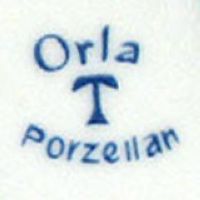
Image 011244-01/02-01
Used between 1891 and 1914.
On April 1st 1891 the foundation stone for the factory later known as Triptiser Porzellanfabrik AG was laid near the Triptis station attached to the Leipzig-to-Saalfeld railroad and after a relatively short building period the first products could be fired a year later. Right from the start the company strongly specialized on household items like rolling pins, cutting boards, storage containers and oil/vinegar cruets as well as a small number of coffee and tea sets. Following the company's initial success it was transformed into a stock corporation in 1896 and this step allowed the first factory expansion in form of an additional production building.
The number of employees quickly rose to total of 440 workers in 1905 and it soon became obvious that various steps had to be taken that would help further growth. One of the first was a doubling of capital stock in 1906 which the same year allowed the takeover of the Porzellanfabrik Gebrüder Urbach in Turn near Teplitz (Bohemia) that itself employed 400 people. Three years later the glass works S. Fischmann Söhne in Prague, Teplitz-Schönau and Eichwald were also taken over, followed in 1912 by the potteries Gebrüder Lichtenstern in Wilhelmsburg (Austria) and 'Ditmars Erben' in Znaim (Moravia). While the other divisions represented a huge growth in productivity, the Triptis main factory had only slightly increased its number of employees and the 450 people working there in 1913 were responsible for producing the best selling items of the whole group which were mainly decorated in the popular 'Strawflower' and 'Blue Onion' styles.
Only a year later the outbreak of WWI halted all further expansion plans and following the general mobilization most factories were closed down until the end of the war. Worse had to come and the complete glass works and both factories in Turn and Znaim were lost after the war as those parts of former Bohemia and Moravia now became parts of the newly-founded state of Czechoslovakia. Nonetheless business continued after the war and even if the following 'Golden Twenties' brought a short upturn not only through an improved export market situation, the worldwide effects of the financial crisis between 1929 and 1933 nearly resulted in total disaster. Still employing 500 people in 1930 the struggling company saw only one option and so the workforce was cut back down to a mere 150 people that worked only three days a week, concentrating on cheap mass-production.
Even if the radical cutback had prevented the company from ending up like so many others and the market situation slowly started to improve, the company remained in a bad shape and in 1938 was taken over by the Porzellanfabrik Oscar Schaller & Co. Nachfolger, which at that time belonged to the Winterling brothers. The takeover itself was greeted in Triptis with mixed feelings but that soon became irrelevant when German forces started to invade Poland. During WWII the factory of course had the same problems as everybody else but still saw itself able to at least provide basic items until mid-April 1945 when Allied bombers targeted the Triptis railway station, leaving a large number of civilian buildings and more than half of the porcelain factory literally pulverised.
Although repairs started directly after the war, the factory was unable to restart production until 1947, now running with four kilns and at first only covering the local demand for bare essentials. As the area around Triptis belonged to the Soviet Occupation Zone, the factory was partially nationalized the same year and soon afterwards it already employed around 120 workers again, a number that was also noted for the year 1949 in which the factory was fully nationalized.
Following the founding of the German Democratic Republic in October 1949 all porcelain and pottery companies in the Triptis area were nationalized and converted into one large VEB combine. In 1952 an impressive 1,500 tons of household items were produced in roughly four hundred firings, but this absolute maximum output also indicated that a larger factory was needed soon. After a relatively long planning phase, a new building on the outskirts of the town was started in 1959 and after its near completion in 1961 and first test firings of the new tunnel kilns at the end of the year it was finally declared ready to take up production in 1962. The whole factory moved to the new premises in a very short time and the old factory was left to be demolished.
In 1968 the factory was put under supervision of the VEB Porzellanfabrik Kahla and during that period it did not have any own marks; as a Kahla subsidiary it had to use a standard 'Kahla' mark. But this combination also had its advantages as the Kahla group also secured orders and so the new Triptis factory quickly advanced to the largest employer in the area, causing a lot of commuter traffic - at peak times it had a workforce of up to 1.000 people with about eighty percent of them being female workers. The situation of the factory remained stable until 1987 when it was released from supervision and was left as a standalone business once again.
After German reunification the company at first was operated under the supervision of the West German Treuhandanstalt that instantly initiated a restructuring process. With a workforce of now 400 people the factory mainly produced items around the 'Romantika' mold with traditional 'Blue Onion' decoration and soon was seen fit to continue as fully privatized company.
Still there was a lot of work to do but after a period of restructuring and reorganisation the company started to take over different other companies and factories. The first mark, brand name and product range to be taken over was that of the Lengsfeld Porzellan AG in Stadtlengsfeld (Thuringia), a company that went bankrupt in 1998. Looking for an investor or a way to continue business, the trademarks and all previous designs were sold to the Triptis Porzellan GmbH & Co. KG. The facility in Stadtlengsfeld fell to the Gilitzer Porzellan Manufaktur GmbH, a new company lead by Erich J. Bruckert who started business on January 1st 1999.
The first company that was taken over was Freiberger Porzellan (Freiberg/Saxony) in the year 1999, however Triptis was only interested in the hotel and restaurantware lines and sold the rest of the Freiberg business late in 2000. The greatest deal by far was the complete takeover of the Gebrüder Winterling group located in Röslau (Bavaria) in 2000, including the Winterling facilities in Windischeschenbach (Bavaria), Kirchenlamitz (Bavaria) and Schwarzenbach (Bavaria). But the Triptis management had bitten off more than they could chew. Confronted with large scaled financial problems, Triptis themselves went insolvent on October 7th 2004 and had to file for bankruptcy a month later.
In June 2005 the company was saved by the investment group under Rolf Frowein which refounded the company and integrated it into the Eschenbach Porzellan group, a sub-division of Frowein Investment. At that time the business included the Eschenbach, Freiberger Hotelporzellan, Triptis and Winterling brands as well as the Neue Porzellanfabrik Ilmenau, which sold items via their factory outlet "HERO Design".
On August 31st 2022 it became known to the public that the Eschenbach Porzellan Group was in dire trouble after gas prices in Germany had massivly increased; this made economic production with gas-fired kilns impossible. A few days later, Frowein announced that the company would cease production at the end of the year and over 90 employees would lose their jobs. The company started to sell off the remaining goods in January 2023. The long history of large scale porcelain production in Triptis had finally come to an end; their website was still active in June 2024.
One of the most puzzling things about these marks is that the company at first used the socialistic "VEB" addition in their marks and later completely dropped any hint on being an East German company; thus many marks show the addition "Made in Germany" instead of the normally found "East Germany", "German Democratic Republic" or "Made in GDR". This is quite unusual; many other companies used the "Made in Germany" until full nationalization in 1972 and then added the socialistic "(Made in) GDR" marks.
Also note that the Triptis company was not the only business that used the "Orla" name in some marks; the Porzellanmanufaktur Union Quist & Kowalski from the town of Kleindembach near Pößneck also used that name, it is the name of a small river in that area.

Image 011244-01/02-01
Used between 1891 and 1914.
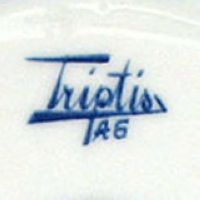
Image 011244-01/02-01
Used between 1896 and 1949. Note the 'A.-G.' standing for 'Aktien-Gesellschaft'.
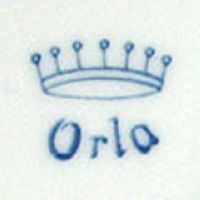
Image 011244-01/02-01
Used between 1931 and 1945, registered at the RWZR under №·444·077 on April 13th 1932.
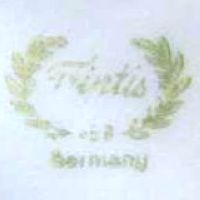
Image 011244-03-03
Used between 1949 and 1960, 'TRIPTIS' over VEB. Note the simple "Germany" addition.
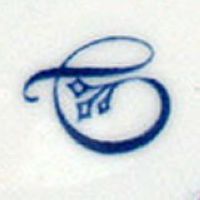
Image 011244-03-04
Used between 1960 and 1968.
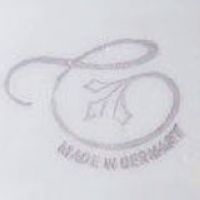
Image 011244-03-05
Used between 1960 and 1968, version with the "Made in Germany".
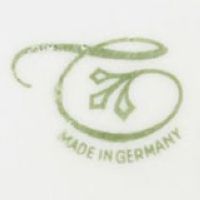
Image 011244-03-06
Used between 1960 and 1968, green version with "Made in Germany".
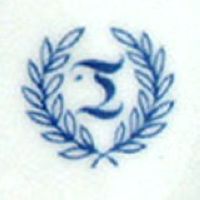
Image 011244-03-07
No exact dates known but this version was definitely used before 1981 and perhaps even before 1968.
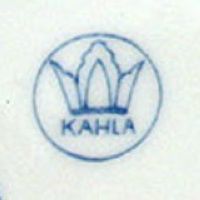
Image 011244-03-08
Used between 1968 and 1987, the standard mark of the Kahla factory.

Image 011244-04-01
Used between 1990 and 2004, either with or without the "Made in Germany" addition.

Image 011244-05-01
Logo used between 2000 and 2004.
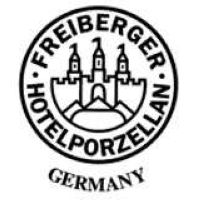
Image 011244-05/06-01
Mark on items of the Freiberger Hotellporzellan brand (1999 until 2008).

Image 011244-06-01
Logo used from 2005 onwards.
© 2004-2025 C.S.Marshall, all rights reserved